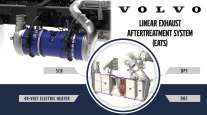Senior Reporter
EPA to Update NOx, Greenhouse Gas Emissions Standards

[Stay on top of transportation news: Get TTNews in your inbox.]
The Environmental Protection Agency announced plans to reduce greenhouse gas emissions and other harmful air pollutants from heavy-duty trucks in a series of major rulemakings over the next three years.
In a statement, EPA said that by December 2022, it will propose and finalize new stringent emission standards to reduce nitrogen oxide pollution from trucks starting in model year 2027.
“This action will include an update of current greenhouse gas standards to capture market shifts to zero-emission technologies in certain segments of the heavy-duty vehicle sector,” EPA said Aug. 5.
EPA Clean Trucks by Transport Topics on Scribd
The existing federal NOx standard for on-highway heavy-duty trucks and engines has not been changed for two decades. Currently, the standard is 0.20 grams per brake-horsepower-hour. EPA has not said what it plans to reduce the next standard to.
The agency said a second rule would set “more robust greenhouse gas emission standards” for new heavy-duty vehicles sold as soon as model year 2030 and beyond.
Now known as the “Clean Trucks Plan,” the agency’s agenda will result in decreased emissions from new heavy-duty vehicles, including longhaul tractors, buses, commercial delivery trucks and other types of trucks.
“These new rules will be major steps toward improving air quality and addressing the climate crisis,” EPA said.
President Joe Biden on Aug. 5 also signed an executive order directed at cutting car and light-duty truck emissions, requiring that 50% of all such vehicles sold by 2030 be electric.

Kedzie
“We’re looking forward to continuing our discussions to educate and help form the next round of low NOx standards,” said Glen Kedzie, energy and environmental counsel for American Trucking Associations.
“Likewise, ATA stands ready to be engaged with both EPA and the National Highway Traffic Safety Administration in the establishment of the next round of truck greenhouse gas and fuel-efficiency standards.”
“With clean technologies advancing at such a rapid pace, it’s inherent for federal agencies to understand how these technologies will be deployed and utilized within individual trucking operations,” Kedzie added.
In an accompanying regulatory update, EPA said pollution from heavy-duty trucks contributes to poor air quality and health across the country, especially in “overburdened and underserved communities.”
“Heavy-duty vehicles are the largest contributor — about 32% — to mobile source emissions of NOx, which react in the atmosphere to form ozone and particulate matter,” EPA said. “These pollutants are linked to respiratory and/or cardiovascular problems and other adverse health impacts that lead to increased medication use, hospital admissions, emergency department visits and premature deaths.”
Heavy-duty vehicles are the largest contributor — about 32% — to mobile source emissions of NOx.
Environmental Protection Agency
The agency said many state and local agencies across the country have asked EPA to issue regulations that further reduce NOx emissions from heavy-duty trucks to protect the health of their communities. “Such reductions are a critical part of many areas’ strategies to attain and maintain the health-based air quality standards, and to ensure that all communities benefit from improvements in air quality,” EPA said.
“One area where technologies can improve emission outcomes relates to trucks operating at what are known as ‘low loads,’ ” the agency said. “EPA’s analysis of trucking emissions has shown that current NOx controls are not effective under certain low-load operating conditions, such as when trucks idle, move slowly or operate in stop-and-go traffic.”
EPA added, “Emission-control technologies that can help reduce NOx emissions under low-load conditions now exist, and they represent one area where EPA intends to focus as it develops a new NOx regulation.”

What's next for data gathering and analytics programs in trucking? Host Seth Clevenger speaks with Andrew Johnson of PrePass Safety Alliance and Chris Orban of Trimble Transportation. Hear a snippet above, and get the full program by going to RoadSigns.TTNews.com.
“Heavy-duty vehicles are the largest contributor — about 32% — to mobile source emissions of NOx, which react in the atmosphere to form ozone and particulate matter,” EPA said. “These pollutants are linked to respiratory and/or cardiovascular problems and other adverse health impacts that lead to increased medication use, hospital admissions, emergency department visits and premature deaths.”
The agency said many state and local agencies across the country have asked the EPA to issue regulations that further reduce NOx emissions from heavy-duty trucks to protect the health of their communities. “Such reductions are a critical part of many areas’ strategies to attain and maintain the health-based air quality standards, and to ensure that all communities benefit from improvements in air quality,” EPA said.
“One area where technologies can improve emission outcomes relates to trucks operating at what are known as ‘low loads,’ ” the agency said. “EPA’s analysis of trucking emissions has shown that current NOx controls are not effective under certain low-load operating conditions, such as when trucks idle, move slowly, or operate in stop-and-go traffic.”
EPA added, “Emission-control technologies that can help reduce NOx emissions under low-load conditions now exist, and they represent one area where EPA intends to focus as it develops a new NOx regulation.”
Want more news? Listen to today's daily briefing below or go here for more info:




